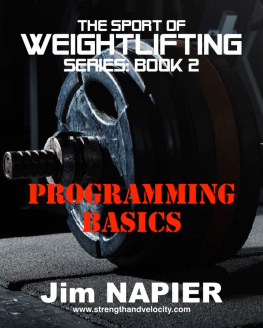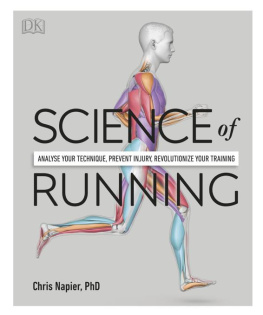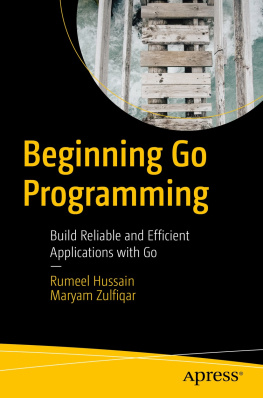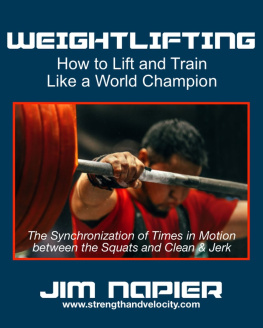Napier - The Sport of Weightlifting Series: Book 2: Programming Basics
Here you can read online Napier - The Sport of Weightlifting Series: Book 2: Programming Basics full text of the book (entire story) in english for free. Download pdf and epub, get meaning, cover and reviews about this ebook. year: 2017, genre: Romance novel. Description of the work, (preface) as well as reviews are available. Best literature library LitArk.com created for fans of good reading and offers a wide selection of genres:
Romance novel
Science fiction
Adventure
Detective
Science
History
Home and family
Prose
Art
Politics
Computer
Non-fiction
Religion
Business
Children
Humor
Choose a favorite category and find really read worthwhile books. Enjoy immersion in the world of imagination, feel the emotions of the characters or learn something new for yourself, make an fascinating discovery.
- Book:The Sport of Weightlifting Series: Book 2: Programming Basics
- Author:
- Genre:
- Year:2017
- Rating:5 / 5
- Favourites:Add to favourites
- Your mark:
- 100
- 1
- 2
- 3
- 4
- 5
The Sport of Weightlifting Series: Book 2: Programming Basics: summary, description and annotation
We offer to read an annotation, description, summary or preface (depends on what the author of the book "The Sport of Weightlifting Series: Book 2: Programming Basics" wrote himself). If you haven't found the necessary information about the book — write in the comments, we will try to find it.
The Sport of Weightlifting Series: Book 2: Programming Basics — read online for free the complete book (whole text) full work
Below is the text of the book, divided by pages. System saving the place of the last page read, allows you to conveniently read the book "The Sport of Weightlifting Series: Book 2: Programming Basics" online for free, without having to search again every time where you left off. Put a bookmark, and you can go to the page where you finished reading at any time.
Font size:
Interval:
Bookmark:
The Sport of Weightlifting Series
Book 2
Basic Programming
The Sport of Weightlifting Series
Book 2
Basic Programming
By Jim Napier Copyright 2017
Note of Rights: All rights reserved. No part of this book may be reproduced or transmitted in any form by any means, electronic, mechanical, photocopying, recording, otherwise, without the prior written permission of the author. jimnapier@sbcglobal.net
Notice of Liability: The information in this book is distributed on an as is basis, without warranty. While every precaution has been taken in the preparations of the book, the author shall not be held liable to any person or entity with respect to any loss or damage caused or alleged to be caused directly or indirectly by the instructions contained in this book.
About the Author
Jim Napier grew up in Fort Worth, Texas. Graduated from Arlington Heights High School in 1963. Was captain of the track team and placed second at the Texas State Meet in the Discus in 1963. Attended Howard County Junior College on an athletic scholarship and placed second in the Junior College Nationals in the discus in 1964 and 1965. Attended TCU on an athletic scholarship. Received a degree in Physical Education in 1968, taking courses in (physics, statistics, biology, kinesiology and Anatomy).
Jim was National Weightlifting Champion in 1977 in the 82.5 kg class and placed second at Nationals in 1975, 1976 and 1978. Set four American records in the snatch, including a Pan American Record snatch of 140 kg in the 75 kg class, American Record snatch 142.5 in the 75 kg class in 1978, and National record snatch of 155 kg in the 82.5 kg class in 1979. Set National and World Record in Masters Division.
Jim has been a member of Spoon Barbell Club Weightlifting Team since 1974 and inducted into Texas Weightlifting Hall of Fame 2009.
Table of Contents
The sport of weightlifting encompasses a unique situation concerning training. Most other sports separate their weight-training with their event(s), i.e., where the athlete perform their event usually is in a separate facility from where they do their weight-training and creates both a physical and mental separation. The separation between the sport and the weight-training is not possible for the weightlifter because they use the apparatus for both their event and their weight-training. The two elements of training and weight-training can be blurred or blended into an overly complicated training regime where the programming can become complex and confusing as well. It can even become detrimental to the lifter if the athlete cannot reconcile these two elements.
The weightlifter might feel like training for their sport is the same as doing weight-training. A squat or muscle snatch is the same as doing a snatch or clean & jerk, a snatch off boxes is the same as doing a snatch off the platform, so on and so forth. This paradox is carried over into the programming aspect of the sport, where the weight-training or auxiliary exercises are commingled and woven in and out of that programming as if there was no difference between the events and the weight-training.
The list of weight-training exercises for gymnastics is relatively specific and is centered more on the Universal Gym then the free weights. Some track & field athletes, particularly the throwers, might lean more toward weightlifting than powerlifting. Competitive swimmers might enjoy a mix between the gymnasts and track & field athletes weight-training regimes.
When I was competing in track & field back in the 60s in high school and college, I used bodybuilding, weightlifting, and powerlifting type exercises. A grand commingling of all three, but always the weight-training took second fiddle to my throwing or track events. When I was practicing the discus, there were no thoughts of weight-training rushing through my mind. I could concentrate entirely on the technique, speed in the ring and flight of the implement without a squat rack or set of barbells lying next to the discus or shot-put ring, as a reminder of what might come next. Since the throwing took precedence, there was never a time when the idea of training hard and long in the weight room ever crossed my mind, because I never wanted to do so much lifting it would disrupt my throwing the next day. However, looking back there is no question that I was overloading far too much in the weight room, and while the snatch and clean & jerk improved considerably from high school to the end of my college days, my discus throw improved very marginally. There goes the theory that doing the snatch and clean & jerk will help other athletes. Later I found out it was never the snatch or clean & jerk but the squats and pulls that would benefit my throwing. There is a very sound and common-sense reason for this dilemma. The very same exercises that assist the snatch and clean & jerk are the very same exercises that assist the throwers and many other athletes. That would be the squats and pulls. For if this is not true, why do weightlifters do squats and pulls? It would be a monumental waste of time if it didnt help the weightlifter to progress their events. Conversely, if it helps the weightlifter to improve their events why would it not help other athletes to progress theirs.
Now we have two dilemmas, the weight room, the place where the lifter trains their main lifts (snatch, clean & jerk and squats and pulls), and the task of separating the auxiliary exercises from those events to develop a training regime that is meaningful and productive. If all the lifts scheduled are treated as primary events, i.e., the snatch being equal to a muscle snatch or hang clean, the lifter will become mediocre in those myriads of events.
Lifting strictly by numbers without knowing what those numbers represent relative to velocity or time-in-motion is how most lifters go about training. The idea that the squats generate a certain amount of force has always been understood and with specific equipment that force can be measured. The idea that it takes a certain amount of time (speed) to stand up out of a clean or squat is somewhat of a foreign concept, at least the lifter doesn't seem to understand the idea of timing the squats enough to know that they should and know how to use that information. It takes more data to manage a weightlifters training than just by the numbers themselves. Certain times-in-motion need to be measured and understood to be able to manage a lifters training and correlate the competition lifts to the squats in a meaningful correlation which can be reflective of the training methodology.
There are several facets of training that usually go undetected, besides the times-in-motion of various lifts and parts of those lifts, there is the correlation of those times that can be linked to all those lifts and set specific parameters or limitations that will keep the training moving in a linear flow. This book will attempt to address these issues, and more, as programming basics unfold.
As stated in the introduction, the idea that the snatch and clean & jerk can be a benefit to other athletes is not always an accurate assumption. The snatch and clean & jerk are the weightlifters events, and other athletes have their events to practice doing so they can become proficient. It makes about as much sense for a competitive swimmer to do the snatch and clean & jerk as it does for the weightlifter to learn how to do the competitive swimmers events. The most touted strength sport is powerlifting, and I dont ever recall powerlifters needing to learn how to snatch and clean & jerk, nor do I recall anyone claiming that it would benefit them to do so. The snatch and clean & jerk have no practical use at all to the powerlifter. The question arises as to whether the snatch and clean & jerk can be learned sufficiently enough for those events to be of benefit to other athletes. They certainly have to be learned well enough to be able to execute them correctly, so there is no chance of injury so that they can become a benefit. The weightlifter who wants to jump into the pool and swim a few laps doesnt need to learn the complexities of the competitive strokes, swim well enough not to drown. It is highly questionable if there is any functionality in taking the time and effort to learn how to do the strokes used by competitive swimmers.
Font size:
Interval:
Bookmark:
Similar books «The Sport of Weightlifting Series: Book 2: Programming Basics»
Look at similar books to The Sport of Weightlifting Series: Book 2: Programming Basics. We have selected literature similar in name and meaning in the hope of providing readers with more options to find new, interesting, not yet read works.
Discussion, reviews of the book The Sport of Weightlifting Series: Book 2: Programming Basics and just readers' own opinions. Leave your comments, write what you think about the work, its meaning or the main characters. Specify what exactly you liked and what you didn't like, and why you think so.












![Mark Lassoff [Mark Lassoff] - Java Programming for Beginners](/uploads/posts/book/119362/thumbs/mark-lassoff-mark-lassoff-java-programming-for.jpg)